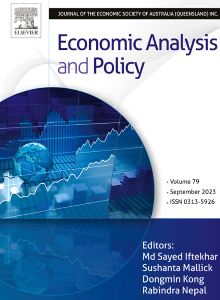进口中间产品嵌入式技术和公司内部技能溢价
IF 8.7
2区 经济学
Q1 ECONOMICS
引用次数: 0
摘要
随着中国日益融入全球价值链,嵌入在进口中间产品中的技术已经成为影响企业内部技能溢价的关键因素,它改变了国内企业熟练和非熟练劳动力投入的分配。本研究利用世界投入产出数据库、中国工业企业数据库和海关数据库的合并数据,通过中间产品产业升级机制,实证考察了进口中间产品技术嵌入对中国企业整体和“双重”技能溢价的影响。在这种情况下,总体技能溢价表示企业内部熟练劳动力和非熟练劳动力之间的工资差距。“双重”技能奖励包括组内和组间组件。群体间技能溢价源于可观察属性(如受教育程度、生产效率)的差异,而群体内技能溢价源于具有相同可观察特征的个体之间不可观察因素(如能力、天资)的异质性。研究结果表明,进口中间产品中嵌入的技术对企业内部的整体技能溢价和“双重”技能溢价都有显著而稳健的抑制作用,与组间技能溢价相比,组内技能溢价的降低更为明显。这种抑制效应在生产部门、企业技能溢价分位数、所有权类型和行业上游之间表现出显著的异质性。机制检验表明,进口中间产品的技术嵌入抑制了国内中间产品产业的升级,从而降低了企业内部的整体和“双重”技能溢价。本文的研究结论为协调中间进口货物贸易高质量发展、完善收入分配制度提供了重要的实证依据和政策见解。本文章由计算机程序翻译,如有差异,请以英文原文为准。
Imported intermediate goods embedded technology and intra-firm skill premiums
With China’s increasing integration into the global value chain, the technology embedded in imported intermediate goods has emerged as a pivotal factor influencing the skill premium within enterprises by altering the allocation of skilled and unskilled labor inputs in domestic firms. This study leverages merged data from the World Input–Output Database (WIOD), the Chinese Industrial Enterprise Database, and the customs database to empirically investigate the impact of technology embedded in imported intermediate goods on the overall and “dual” skill premiums within Chinese enterprises through the mechanism of intermediate goods industry upgrading. In this context, the overall skill premium denotes the wage disparity between skilled and unskilled labor within enterprises. The “dual” skill premium encompasses both within-group and between-group components. The between-group skill premium arises from discrepancies in observable attributes (e.g., educational attainment, productive efficiency), whereas the within-group skill premium stems from the heterogeneity of unobservable factors (e.g., capabilities, aptitudes) among individuals with identical observable characteristics. The findings reveal that the technology embedded in imported intermediate goods exerts a significant and robust dampening effect on both the overall and “dual” skill premiums within enterprises, with a more pronounced reduction in the within-group skill premium compared to the between-group skill premium. This dampening effect exhibits significant heterogeneity across production sectors, enterprise skill premium quantiles, ownership types, and industry upstreamness. Mechanism tests indicate that the technology embedded in imported intermediate goods reduces the overall and “dual” skill premiums within enterprises by inhibiting the upgrading of domestic intermediate goods industries. The conclusions of this study provide crucial empirical evidence and policy insights for coordinating the high-quality development of intermediate imported goods trade and refining the income distribution system.
求助全文
通过发布文献求助,成功后即可免费获取论文全文。
去求助
来源期刊

Economic Analysis and Policy
ECONOMICS-
CiteScore
9.80
自引率
9.20%
发文量
231
审稿时长
93 days
期刊介绍:
Economic Analysis and Policy (established 1970) publishes articles from all branches of economics with a particular focus on research, theoretical and applied, which has strong policy relevance. The journal also publishes survey articles and empirical replications on key policy issues. Authors are expected to highlight the main insights in a non-technical introduction and in the conclusion.
 求助内容:
求助内容: 应助结果提醒方式:
应助结果提醒方式:


